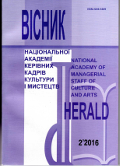HISTORICAL FEATURES OF THE DEVELOPMENT OF ARMENIAN ARMS MANUFACTURING IN UKRAINE
DOI:
https://doi.org/10.32461/2226-3209.2.2016.138500Keywords:
Armenians, attribution, firearm mark, gunsmith, powder flask, sword, weapon, gunAbstract
The purpose of the research. The main task of the article is to show the specificity of historical development of one of the principal types of art crafts of Armenians in Ukraine – arms manufacturing and to study problems of scientific research of this subject. The special attention is given to the questions of attribution of the weapon made by Armenian craftsmen. The methodology of research includes methods of historical analysis and synthesis and also a method of interpretation. Scientific novelty of the research consists in substantiation of necessity to study the problem of the specificity of the Armenian arms manufacturing in Ukraine as an original phenomenon. Conclusions. Problems in this sphere are connected with historical destiny of Armenians. Most of Armenian artisans lived and worked in Diaspora, at the same time weapons are usually attributed to the country of their manufacture. Therefore, names of many Armenian armourers are known from historical documents, but the concrete samples of their work are unknown, and as a result, characteristic style features of the work of a concrete master are also unknown.
Downloads
Published
Issue
Section
License
Authors who publish with this journal agree to the following terms:
1. Authors retain copyright and grant the journal right of first publication with the work simultaneously licensed under a Creative Commons Attribution License International CC-BY that allows others to share the work with an acknowledgement of the work's authorship and initial publication in this journal.
2. Authors are able to enter into separate, additional contractual arrangements for the non-exclusive distribution of the journal's published version of the work (e.g., post it to an institutional repository or publish it in a book), with an acknowledgement of its initial publication in this journal.
3. Authors are permitted and encouraged to post their work online (e.g., in institutional repositories or on their website) prior to and during the submission process, as it can lead to productive exchanges, as well as earlier and greater citation of published work (See The Effect of Open Access).


